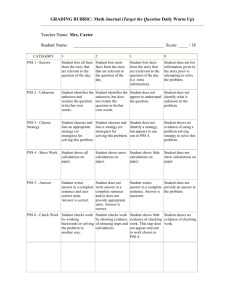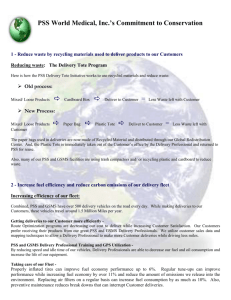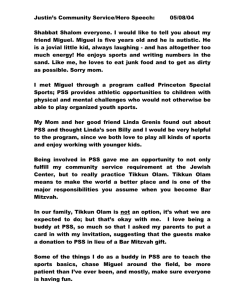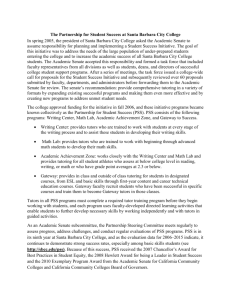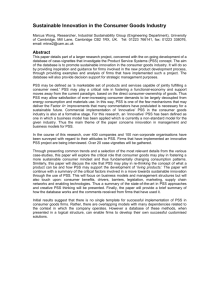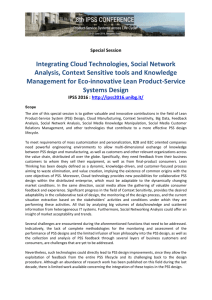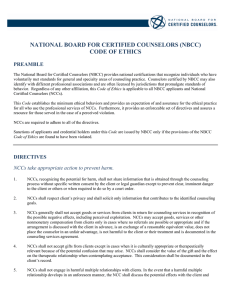Ruth Presentation - Vicotorial Falls 1
advertisement
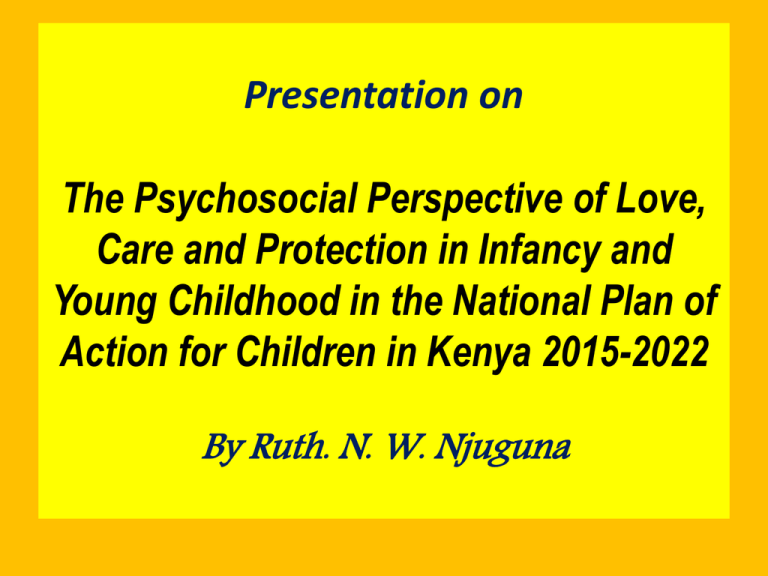
Presentation on The Psychosocial Perspective of Love, Care and Protection in Infancy and Young Childhood in the National Plan of Action for Children in Kenya 2015-2022 By Ruth. N. W. Njuguna 2 Introduction to the National Plan of Action The Government of Kenya has in place the Kenya Vision 2030 which is a national long-term development blueprint to create a globally competitive and prosperous nation with a high quality life by 2030. The Vision has three pillars namely Economic, Social and Political all aimed at providing love care and protection for children. Under the Social Pillar one of the flag ship projects is the development of the NPA. The Government of Kenya under the National Council for Children’s Services (NCCS) recently launched the third National Plan of Action (NPA) in Kenya 2015-2022. It was developed in collaboration relevant Government line Ministries, Departments and Agencies, key developments partners and stakeholders. The NPA provides an operational framework to guide stakeholders and partners in coordinating, planning, implementing and monitoring programmes for the child. In addition, it outlines priorities and interventions necessary for the progressive realization of children’s rights in Kenya. It has been aligned to the Constitution of Kenya and informed by:- Children Act, 2001. - National Children’s Policy. - UNCRC. - ACRWC. - 2012 and 2015 Economic Surveys Among other relevant documents It is structured into four pillars which are: - Right to Survival. - Right to Development. - Right to Protection. - Right to Participation. Right to Survival It focuses on infancy and young childhood under the following areas: Maternal Health A mother’s good health represents the child’s best hope for survival. When a mother dies, is weakened by disability or is overwhelmed by the needs of many children her children’s lives are threatened – and too often lost. Conversely, if a mother’s health and well-being are supported together with child survival efforts, then mothers, children and the entire society benefits. To achieve this mother must have antenatal and postnatal care, skilled delivery, access to family planning, and post natal care. A large proportion of maternal and neonatal deaths occur during the first 48 hours. Postnatal care is therefore important for both mother and child, to treat complications arising from delivery as well as to provide the mother with important information of how to care for herself and the child Others are:Enhanced Immunization. Balanced Nutrition Safe drinking water and sanitation. Control and management of malaria, pneumonia, diarrhea and HIV and AIDS among others. - Children with disabilities, special needs, chronic illnesses and conditions. Health sector service delivery. Addressing the above issues appropriately ensures that infants and young children not only receive curative and preventive health but also sound child development. Right to Development The NPA refers to Child Development as various dimensions that are physical, social, emotional, cognitive and spiritual. To achieve holistic child development children have a right to:- Education. - Recreation, leisure, play and cultural. activities. - Access to appropriate information - Parental and family care. Right to Protection Findings from the VAC report, 2010 and research carried out by NCCS and KNBS indicate that child abuse cases are on the rise. The highest percentage perpetrators of children being parents. This is an indicator that apart from rescuing children from child abuse a lot needs to be done on their social emotional well- being. The NPA has therefore factored the up scaling of psychosocial support programmes for abused children . The programmes include empowering children, families and communities on psychosocial care and support Further, child abuse and other forms of child exploitation are compounded by child poverty. Forty six per cent of the Kenya population live below the poverty line. Studies by Duncan, Brook –Gunn 1997 on child outcomes of child well-being indicates that poor children suffer higher incidences of adverse health, developmental and other outcomes than non poor children. On cognitive abilities children living below the poverty threshold are 1.3 times as likely as non-poor children to experience learning disabilities and developmental delays. The Government of Kenya has therefore upscaled social protection programmes for OVC’s and school bursaries to minimize the risks of their vulnerability. Right to Participation The NPA is makes reference to the Guidelines for Child Participation in Kenya(Revised 2014) which recognize the meaningful children’s participation ought to take place in various decision making levels that include the:- home, school,community,national,regional and international levels It is therefore envisioned the provision love, care and protection of children will increase the chances of the children to maximally participate on issues concerning them at all the above mentioned levels. METHOD The overall Management, Oversight and Coordination of the NPA is the responsibility of the NCCS with support from relevant stakeholders. The implementing arm of the NCCS are the County, Sub-County and Ward Area Advisory Councils. Composition of the NCCS and the County, Sub-County and Ward levels includes:- Relevant line Ministries, Department and Agencies - Non-Governmental Organizations - Faith Based Organizations - Business Community. Functions of the AAC’s are: - To supervise and regulate planning, financing and coordination of children welfare programmes in the County Sub County and ward levels. - Mobilize resources and facilitate funding for identified programmes. - Advocacy, promote and create public awareness on children programmes. - Facilitate Partnership and networking among stakeholders. - Facilitate capacity building of all stakeholders and service providers. - Facilitate strengthening of data collection and creation of data banks. - Monitor, evaluate and report on the implementation of Child Rights and Welfare activities. All the above functions will ensure that PSS is well implemented. The AACs will therefore supervise, plan, finance and coordinate the provision of PSS at the various level. Resources will also be mobilized through seeking funds from County Governments during the budgeting process. Advocacy, promotion and creation of public awareness on PSS will be prioritized. Public awareness at all levels will be carried out together with the Ministry of Interior and Coordination where the communities are sensitized on various child issues during barazas. Dissemination of the NPA will also be done together with any other material that mainstream PSS such as the Good Practice in Child Care: A Manual for Children Caregivers that have been developed by NCCS Partnerships with organization that offer PSS services will be important for referral services. Capacity building will be done to members of the AAC’s on PSS Children Officers and those working with and for children. There will be sex disaggregated data collection on those trained on PSS and the Number of Children who have been provided with PSS. To Monitor, evaluate and report on PSS information will flow from the Ward AAC, Sub County AAC upto the CAAC which will forward the same to the NCCS. The NCCS work in four thematic areas one of them being Policy and Legal Issues Development. The NCCS will strive to develop policies that mainstream PSS focusing on love, care and protection for implementation. RESULTS Results of implementation of the Plan will strengthen the ability of families and communities to provide love, care and protection for infants and young children. The indicators will include:- - Increase in the number of Children accessing PSS. - - Increase in the number of Human Resource working with and for children that have been trained on PSS. Increased budgetary allocation for PSS programmes. Increase in the Number of PSS programmes. - Increase on the number of PSS sensitization and forums. - Increase in the number of families and communities accessing PSS - Increase in the number of policies that mainstream PSS. CONCLUSION One’s childhood plays a vital and active role in a persons development. According to (Erikson 1959) successful completion of each stage results in a healthy personality and the acquisition of basic virtues. Therefore by Kenya mainstreaming PSS in its policies and programmes for infants and young children will produce quality lives and the nation will have higher chances of have social order in realization of Vision 2030. “It is easier to build strong children than to repair broken men” Frederick Douglass

